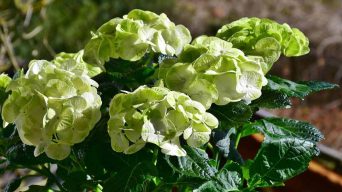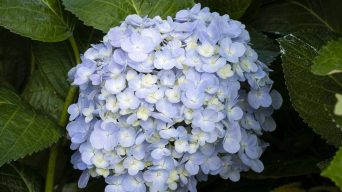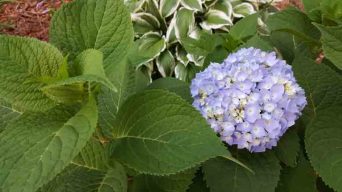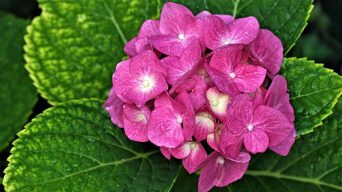Hydrangea plants are beautiful flowering shrubs that add color and life to any garden.
But sometimes, even with the best care, these plants can start to die.
If your hydrangea is dying, don’t despair!
Several possible causes and solutions can help you save your plant.
Why Is My Hydrangea Dying?
There are many possible reasons why your hydrangea plant might be dying.
Here are 11 of the most common causes:
1. Too Much Water
One of the most common reasons hydrangeas die is too much water.
Hydrangeas need moist soil, but they cannot tolerate being waterlogged.
If the soil around your plant is constantly wet, it can start to suffocate the roots and cause the plant to die.
How To Tell If Your Hydrangea is Overwatered
There are a few signs that you can look for to tell if your plant is being overwatered:
- The leaves will be wilted and droopy
- The leaves may start to turn yellow or brown
- Mushy or rotting roots
- Flowers that are brown and wilted
How To Save an Overwatered Hydrangea
If you think your hydrangea is being overwatered, the first thing you should do is check the soil.
You will need to improve the drainage if it is soggy or waterlogged.
To improve the texture and drainage of the soil, you can add some organic matter, such as compost.
You may also need to increase the number of drainage holes in the pot or planting area.
Once you have improved the drainage, be sure to water your plant less frequently.
Allow the soil to dry out somewhat between watering to give the plant a chance to recover.
2. Too Little Water
Another common reason for hydrangeas to die is too little water.
Hydrangeas must be watered regularly, especially during hot weather, to prevent them from drying out.
If the soil around your plant is allowed to get too dry for too long, the plant will start to wilt, and the hydrangea leaves will turn brown.
An underwatered hydrangea cannot take up the water it needs to survive, so it will start to die.
How To Tell If Your Hydrangea is Underwatered
There are a few signs that you can look for to tell if your plant is being underwatered:
- The leaves will be wilted and droopy
- The leaves may start to turn brown
- The leaves are dry and crunchy
- The plant is not growing
How To Save an Underwatered Hydrangea
If you think your Hydrangea is being underwatered, you should first check the soil.
If it is dry or dusty, it needs to be watered.
Be sure to water deeply so that the water reaches the plant’s roots.
You may need to water your plant more frequently during hot weather.
Hydrangea plants need to be watered about once a week during the summer.
3. Too Much Sunlight
Another possible reason for your hydrangea to die is too much sunlight.
Hydrangeas need some sunlight to thrive, but they cannot tolerate being in direct sun all day long.
If the plant is in direct sunlight for too long, the leaves will start to burn and turn brown.
The plant may also stop blooming.
How To Tell If Your Hydrangea is Getting Too Much Sunlight
There are a few signs that you can look for to tell if your plant is getting too much sunlight:
- The leaves are brown and crispy
- The leaves are falling off the plant
- The plant is not blooming
- The leaves have brown patches
How To Save a Hydrangea That Is Getting Too Much Sunlight
If you think your plant is getting too much sun, the first thing you should do is move it to a shady spot.
Hydrangea plants need to be in an area with morning sun and afternoon shade.
East- or west-facing locations are ideal. This will give the plant enough light to bloom but protect it from the hot afternoon sun.
4. Too Little Sunlight
Another possible reason for your hydrangea to die is too little sunlight.
They need some sunlight to bloom, so if they are not getting enough light, they may stop blooming.
Hydrangeas will also become leggy and stretch out, trying to reach for the light.
When a Hydrangea is not getting enough light, it cannot produce the food it needs to survive.
How To Tell If Your Hydrangea is Getting Too Little Sunlight
There are a few signs that you can look for to tell if your plant is getting too little sunlight:
- The plant is not blooming
- The leaves are pale
- The leaves are small
- The plant is leggy
- The plant growth is slow
How To Save a Hydrangea That Is Getting Too Little Sunlight
If you think your plant is not getting enough sunlight, the first thing you should do is move it to a sunnier spot.
Hydrangea plants need to be in a spot with at least 6 hours of sunlight daily.
They thrive in locations that get morning sun and afternoon shade.
The best place to put your plant is in an east- or west-facing location. This will give the plant enough light to bloom but protect it from the hot afternoon sun.
5. Poor Drainage
Another possible reason for your hydrangea to die is poor drainage.
Hydrangeas need well-drained soil to thrive. If the soil is too wet, it can cause the plant to rot.
The roots will not be able to get the oxygen they need, and the plant will start to die.
They also need a pot with drainage holes to prevent the roots from sitting in water.
How To Tell If Your Hydrangea Has Poor Drainage
There are a few signs that you can look for to tell if your plant has poor drainage:
- The leaves are wilted and droopy
- The leaves have turned yellow
- The plant is not growing
- Mushy or rotten roots
How To Save a Hydrangea With Poor Drainage
If you think your plant has poor drainage, the first thing you should do is check the soil.
If it is waterlogged, you will need to improve the drainage.
The best way to do this is to add some organic matter to the soil. This will help to improve the drainage and aerate the soil.
You can also add a gravel layer to the pot’s bottom to improve drainage.
You also must ensure the pot has drainage holes to prevent the roots from sitting in water.
6. Rootbound
Another possible reason for your hydrangea to die is that it is rootbound.
Hydrangeas need room to grow; if they are potbound, their roots will not have enough space.
The plant will not be able to get the nutrients and water it needs to survive.
The roots will also start to grow out of the pot, which can cause the plant to topple over.
How To Tell If Your Hydrangea Is Rootbound
There are a few signs that you can look for to tell if your plant is rootbound:
- The roots are growing out of the bottom of the pot
- The plant is not growing
- The plant is wilting
- The leaves are yellow or brown
How To Save a Rootbound Hydrangea
If you think your hydrangea is rootbound, the first thing you should do is repot it.
Choose a pot that is 2-3 times the size of the current pot and has drainage holes.
Fill the bottom of the pot with gravel to improve drainage.
Then, carefully remove the plant from the pot and loosen the roots.
You may need to trim the roots if they are too long.
Place the plant in the new pot and fill it with fresh potting soil.
7. Temperature Stress
Another potential cause of your hydrangea’s decline is temperature stress.
Hydrangeas are sensitive to extreme temperatures, and their health can deteriorate when subjected to excessive heat or cold.
Signs of temperature stress in hydrangeas include the yellowing or browning of leaves and stunted growth, and if left unaddressed, it can ultimately lead to the plant’s demise.
How To Tell If Your Hydrangea Is Suffering From Temperature Stress
There are a few signs that you can look for to tell if your plant is suffering from temperature stress:
- The leaves are wilted or droopy
- The leaves are yellow or brown
- The leaf’s edges are curled
- The plant becomes mushy and turns black
- The plant is not growing
How To Save a Hydrangea From Temperature Stress
If you think your hydrangea is suffering from temperature stress, the first thing you should do is move it to a more protected location.
Choose a spot out of the direct sun and where the temperature stays between 60-80 degrees Fahrenheit.
You may also need to provide extra humidity for the plant if the air is too dry.
You can place a tray of water beneath the pot or use a humidifier.
8. Nutrient Deficiency
Another possible reason for your hydrangea to die is a nutrient deficiency.
Hydrangeas need certain nutrients to grow; if they are deficient in any of them, the plant will start to die.
The most common nutrient deficiencies in hydrangeas are nitrogen, phosphorus, and potassium.
When your plant is lacking in nitrogen, the leaves will turn yellow.
If it lacks phosphorus, the hydrangea flowers will be small, and the plant will be stunted.
And if it lacks potassium, the leaves will have brown edges, and the plant will be less resistant to disease.
How To Tell If Your Hydrangea Is Deficient In Nutrients
There are a few signs that you can look for to tell if your plant is deficient in nutrients:
- The leaves are yellow
- The flowers are small
- The leaves have brown edges
- The plant is stunted
- The plant is less resistant to pests and diseases
How To Save a Hydrangea From a Nutrient Deficiency
If you think your hydrangea is deficient in nutrients, you first should fertilize it.
Choose a fertilizer high in nitrogen, phosphorus, and potassium and follow the directions on the package.
You should also make sure your plant is getting enough water.
Hydrangeas need at least 1 inch of water per week.
You may also need to repot the plant in fresh potting soil. This will give the plant a boost of nutrients.
9. Overfertilization
While fertilizing your hydrangea is essential, it can also overfertilize the plant.
This can happen if you use too much fertilizer or if you fertilize too often.
Overfertilization will cause the roots to burn and the leaves to turn yellow or brown.
The plant may also become stunted and produce fewer flowers.
How To Tell If Your Hydrangea Is Overfertilized
There are a few signs that you can look for to tell if your plant is overfertilized:
- The lower leaves are yellow and wilting
- The leaves are falling
- The leaf tips are brown
- There is little or no new growth
- The plant is stunted
How To Save a Hydrangea From Overfertilization
If you think your plant is overfertilized, the first thing you should do is flush the roots.
To do this, water the plant deeply and then let the water drain out completely.
Do this once a week for three weeks.
After flushing the roots, you should stop fertilizing the plant for a few months.
10. Pest Infestation
Pests can also be a reason for your hydrangea to die.
Several pests can infest hydrangeas, including aphids, scale insects, and mealybugs.
Aphids are small, green insects that suck the sap from the leaves.
This can cause the leaves to turn yellow and eventually die.
Scale insects are small, brown insects that attach themselves to the stems and leaves of the plant.
They also suck the sap from the plant, which can cause the leaves to turn yellow and eventually die.
Mealybugs are small, white insects that feed on the plant’s sap.
They can cause the leaves to turn yellow and eventually die.
How To Tell If Your Hydrangea Is Infested With Pests
There are a few signs that you can look for to tell if your plant is infested with pests:
- The leaves are yellow or drop off
- The leaves are wilting
- There is damage to the leaves
- The plant has a sticky substance on it
- There are small insects on the plant
- The plant is stunted
How To Save a Hydrangea From a Pest Infestation
If you think your hydrangea is infested with pests, the first thing you should do is try to remove the pests by hand.
Use a cotton swab dipped in alcohol to kill the aphids, scale insects, and mealybugs.
You can also use a natural pest control method, such as insecticidal soap or neem oil.
You should also keep your plant clean and free of debris.
This will help prevent pests from infesting your plant.
11. Diseases
Diseases can also be a reason for your hydrangea to die.
Several diseases can affect hydrangeas, including powdery mildew, leaf spot, and root rot.
Powdery mildew is a white powdery fungus that grows on the leaves and stems of the plant.
Leaf spot is a dark brown or black spot that appears on the plant’s leaves.
Root rot is a fungal disease that affects the roots of the plant.
How To Tell If Your Hydrangea Has a Disease
There are a few signs that you can look for to tell if your plant has a disease:
- The leaves are discolored
- The leaves have brown spots on them
- The leaves have a white powdery substance on them
- The plant is not growing as well as it should be
- The plant has a foul odor
How To Save a Hydrangea From a Disease
If you think your hydrangea has a disease, you should first isolate the plant from other plants.
This will help prevent the disease from spreading.
You should also remove any affected leaves or stems, and keep it clean and free of debris.
A fungicide or bactericide can also be used on the plant. This will help prevent diseases from affecting your plant.
Final Thoughts
As you can see, there are several reasons your hydrangea might be dying.
However, there are also some solutions that you can try to save your plant.
If you think your plant is dying, you should first try to determine the cause.
Once you know the cause, you can take the necessary steps to save your plant.
Don’t give up on your plant just yet! There’s still a chance that you can save it.







